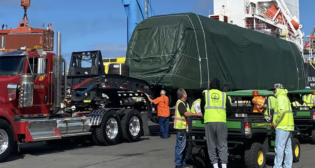
MTA labor talks: Cannon to left, cannon to right
Written by William C. Vantuono, Editor-in-ChiefAnd so it is that protracted contract talks on wages, benefits and work rules affecting those commuter railroads have failed to produce a single new ratified agreement—hardly what New York Gov. Andrew Cuomo, a Democrat, expected after exacting from the state’s public employee unions a concessionary five-year contract with an initial three-year wage freeze, and just a 4% wage increase over the final two.
The cudgel used by Cuomo on state employee unions was the threat of massive furloughs; but the MTA cannot mimic such intimidation. Furloughing operating crews, for example, would immediately cause the quantity, quality and safety of commuter rail—operated over lengthy geography without direct supervision—to deteriorate hurriedly.
Still, the MTA is feeling formidable pressure from the state capital in Albany. Cuomo, presiding over a $1.3 billion state budget deficit, says, “There is no piggybank in Albany anymore” for state agencies. Yet the unions observe that the MTA recently acknowledged a $1.9 billion budget surplus, helped along by a 9% increase in state subsidies.
Regardless, the MTA—whose non-contract employees are in their fourth year of a wage freeze, and whose expense for wages, overtime, health care and pensions consume almost 60% of MTA spending—is demanding from its rail unions a “net zero” in labor costs, obtained via a combination of wage freezes, work rules liberalizations and other concessions. The MTA has an outstanding $31 billion debt.
Dampening the objective of extending the state-employee wage freeze pattern to unionized MTA rail workers is a 2012 five-year Amtrak settlement boosting unionized worker wages by 15%, and with only modest increases in healthcare insurance cost-sharing. While Amtrak is not part of the MTA—and surely more cash-strapped—union negotiators frequently seek patterns (sometimes called “comparability”) favorable to their members. Similarly, the MTA is seeking comparability with state employee contracts. Not lost on the MTA is that Amtrak settlements historically mirror those on privately held and highly profitable freight railroads.
More troubling to MTA management are agreements being offered on commuter rail agency Chicago Metra, which, if ratified, will provide unionized workers a 20% pay boost over six years plus a $3,000 signing bonus.
The MTA thought it had an agreement for a two-year initial wage freeze and a 10% increase over six years on Metro-North with the Association of Commuter Rail Employees (ACRE), which represents Metro-North conductors and engineers. But the rank-and-file voted it down by a three-to-one margin after other MTA labor unions—including other Metro-North unions—criticized the tentative pact. ACRE often is criticized as too cozy with management—an allegation given substance by a New York tabloid in 2003 when Congress voted to block the MTA from using federal transit subsidies to pay ACRE officers’ salaries, benefits and expenses.
On LIRR, two years of mediated talks with a labor coalition have failed to produce an agreement, leading the National Mediation Board to declare a bargaining impasse earlier this month. The LIRR labor coalition declined binding arbitration, putting in place Railway Labor Act (RLA) procedures stretching over 270 days that could involve two presidential emergency boards before a work stoppage might occur. LIRR management had sought a three-year immediate wage freeze followed by a 4% wage increase over the final two years—considerably less than rejected by ACRE members on Metro-North, and well below the most recent Amtrak agreements.
With LIRR and its unions now locked in RLA time-defined events, it is probable LIRR labor contracts will be finalized before Metro-North and SIR reach ratified settlements with their unions, leaving LIRR to set the pattern. The dominant subway labor organization, Local 100 of the Transport Workers Union, says it is not necessarily awaiting a pattern to be established by LIRR and its unions even though LIRR workers have the highest—or near highest—hourly wage rates for transit workers nationwide. In fact, several previous LIRR agreements followed a pattern established by TWU Local 100. Patterns, when followed, can also benefit management in that they prevent attempts at leapfrogging by unions that lag in settlements.
Interestingly, MTA labor/management relations are governed by two separate laws. LIRR and Metro-North are under Railway Labor Act coverage, while SIR and NYCT are covered by New York’s Public Employees Fair Employment Act (commonly known as the Taylor Law). While work stoppages can occur after all provisions of the RLA run their course, the Taylor Law—enacted by the New York legislature following a costly 1965 transit strike—curtails a right to strike and requires binding arbitration. In two instances since the Taylor Law’s inception, however (1980 and 2005), the TWU engaged in a work stoppage resulting in stiff fines.
A work stoppage on just one of the MTA railroads would bring much of the New York metropolitan region’s rail public transit to a halt; but a work stoppage is not contemplated by the parties. Yet, if the MTA holds firm in its demands, avoiding a work stoppage will be a challenge worthy of sailors in Greek mythology passing through the narrow strait inhabited on either side by the monsters Charybdis and Scylla. A slight error in navigation by either side could deliver to the region massive economic losses, a harsh temporary reduction in quality of life, and hostile political repercussions.
Indeed. Although public transit is essential to only 15% of Americans outside the New York metropolitan area, four of every five of those living and working within it depend on MTA operated public transit.
Politics looms large in eventual settlements as the politically appointed MTA board of directors sets and adjusts bargaining objectives. The governor nominates all board members—subject to state senate confirmation—with the governor making initial recommendations for chairman, vice chairman and four other members of the 17- voting-member MTA board, while the Mayor of New York recommends to the governor for nomination four additional members. Five current MTA board members were nominated by Cuomo, and if, as expected, he seeks another term in 2014, the remainder might depend on him for renomination.
As politicians rarely fare well when the trains stop running, the 270-day RLA clock that is running could play a role, as it expires just ahead of the thick of congressional, state legislature and gubernatorial campaigning for the November 2014 elections.
Then there is the matter of possibly two presidential emergency boards (PEBs) in the LIRR dispute. Members of both (if it comes to that) PEBs will be appointed by labor-friendly President Obama. (Note that while the RLA provides for only a single PEB in freight and Amtrak contract disputes, a special RLA provision provides for two PEBs where commuter railroad negotiations fail to produce voluntary agreements. If recommendations of the first PEB do not lead to a negotiated settlement, labor and management submit to a second PEB final settlement recommendations, with the PEB choosing the one it considers the most reasonable.)
Failure of LIRR to settle on recommendations of a first or second PEB could result in a work stoppage, but such a stoppage almost certainly would produce congressional back-to-work legislation—and here it gets dicey for the unions, as the Republican controlled House likely would write the bill. While Congress typically follows PEB recommendations, there have been instances where Congress has written its own terms to end a rail strike, and the Republican-controlled House is hardly a labor friendly lot.
Moreover, New York’s largely Democratic congressional contingent would not be happy with a transit strike thrown in its lap just prior to an election, creating concerns for labor as to how the Democratic controlled Senate would react to a Republican-controlled House back-to-work order that is, in fact, a third-party written labor agreement.
For sure, politics profoundly influences labor/management relations among passenger rail operators serving commuters and straphangers in New York. What neither side has—but surely has necessity for—is Number 42 (Mariano Rivera) coming out of the bullpen to nail down a reasonable voluntary agreement. The alternative—cannon to the right, cannon to the left, volleying and thundering—promises only what Lord Tennyson described in The Charge of the Light Brigade: “Into the jaws of death, into the mouth of hell.”
A bit of history
While not germane to negotiations under way, some readers may have interest in the evolution of the MTA and its separate railroad properties.
Prior to the 1960s, intercity passenger and commuter rail operations were performed by privately owned freight railroads as required by the Interstate Commerce Commission (now Surface Transportation Board), with wages, benefits and work rules largely negotiated on a national basis. Thus, for example, conductors, engineers, clerks, shopcraft employees and maintenance-of-way workers on commuter railroads received similar pay as their counterparts on freight railroads.
LIRR, serving the length of Long Island, is the busiest commuter railroad in the nation (some 82 million riders annually). It once was a wholly owned subsidiary of former Pennsylvania Railroad (PRR), carrying passengers and freight. LIRR tumbled into bankruptcy in 1949, with the State of New York volunteering to subsidize its continued operations. Four months prior to the 1968 merger of PRR and New York Central, which formed Penn Central, New York Gov. Nelson Rockefeller superintended a state purchase of LIRR, paying PRR $65 million, plus accepting $54 million in LIRR debts.
The state created the MTA (then the Metropolitan Commuter Transportation Authority) to operate LIRR (including its freight operation) and negotiate its RLA-governed labor agreements. In 1997, LIRR’s freight operations were franchised to short line New York & Atlantic Railway. As it is, as was PRR, part of a connecting interstate railroad network, and as LIRR is responsible for track maintenance and other facilities used by the freight railroad, LIRR’s labor/management relations remain governed by the RLA.
Metro-North, the second busiest commuter railroad in America, includes former commuter operations of New York Central Railroad and New York, New Haven & Hartford. Penn Central acquired those operations, and following PC’s bankruptcy, the states of New York and Connecticut began providing subsidies. In 1983, after creation of Conrail—the federally financed successor to Penn Central—the MTA acquired those commuter operations, renaming them Metro-North Commuter Railroad. As the MTA maintains track and other facilities stretching into Connecticut under contract to that state, and because its track also hosts interstate Amtrak trains, Metro-North’s labor/management relations remain governed by the RLA.
SIR, which operates modified New York City subway cars, traces passenger and freight operations to its onetime parent, Baltimore & Ohio Railroad (now part of CSX). Its passenger operations and all track and facilities were acquired by the MTA in 1971, with the B&O continuing to operate freight trains over SIR-maintained track. In 1986, freight operations, which had been transferred by CSX to a short line owned by Delaware Otsego, were abandoned, ending SIR’s obligation to maintain facilities for freight service that was connected to the national rail network. This allowed SIR to shift its labor/management relations from the orbit of the RLA to New York State’s Public Employees Fair Employment Act (Taylor Law).
New York City subways, America’s largest-ridership transit system (more than 1.6 billion passengers annually), moved from private to public ownership prior to World War II. The subways were placed under control of the New York City Transit Authority in 1953, and transferred to the MTA in 1968. Subway labor/management relations are subject to the Taylor Law.
One final note
The New York City mayoral election, to choose a successor to Michael Bloomberg, is Nov. 5. The Republican candidate, Joseph Lhota, is a former chairman of the MTA (January 2012-December 2012), having been nominated by Cuomo. But his challenger, Democrat Bill de Blasio, has a 45-point lead in the polls and backing from Cuomo. Although de Blasio has a hard-left political tilt, he has had difficulty winning enthusiastic union endorsements.
(Frank N. Wilner is author of Understanding the Railway Labor Act; Amtrak: Past, Present, Future; and Railroad Mergers: History, Analysis, Insight, all available at www.transalert.com.)



